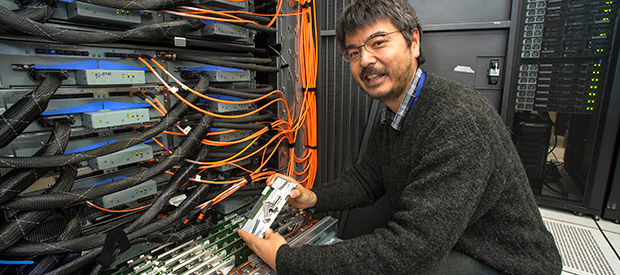 RIKEN BNL Research Center
RIKEN BNL Research Center

Lattice QCD Computational Physics
The interaction between quarks and gluons is very strong and complicated. Especially at low energies, quarks interact so strongly that they involuntarily break a symmetry called "chiral symmetry" of the massless quark. This spontaneously broken symmetry (Yoichiro Nambu was awarded the 2008 Nobel Prize for this discovery) largely manifests itself in various aspects of the proton and neutron, as well as mesons (pions, kaons), which are constituted from quarks and gluons. For example, the origin of mass of the proton could be understood as a consequence of this broken symmetry.

QCDOC Supercomputer
Lattice QCD is a theoretical method to investigate this complicated strong dynamic of QCD based on the first principles. In the late 1990's RBRC researchers , along with others made a breakthrough in this area: realizing chiral symmetry on lattice using the domain-wall fermion (DWF) method, which turns out to be very useful to investigate QCD.
Since then, the lattice QCD project team at RBRC has been investigating QCD using DWF for more than ten years. Our studies, which are not only theoretical investigations on QCD, but also include constructing high performance supercomputers specialized for QCD computations, or developments for better algorithms to accelerate calculations, are about to lead us to achieve solid understandings about various facets of QCD without any compromise.
QCDOC Supercomputer
Lattice QCD calculations have been performed on the worlds fastest supercomputers at the time of their installation. The lattice QCD team at RBRC has been developing special purpose supercomputers. The first machine, QCDSP (QCD with DSP), was installed in 1998 collaborating with Columbia University, whose success lead to the current QCDOC (QCD on a chip), in collaboration with Columbia University and IBM, and began operation in 2005. QCDOC is about 20 times faster than QCDSP yet it has a smaller footprint and lower power consumption. Two other QCDOCs are also installed by the Department of Energy and the University of Edinburgh.
RBRC Research Areas
-

Quantum Chromodynamics
Research into phenomena caused by the Strong Force
-

Spin Physics
Experimental attempts to measure quark and gluon spin and their distribution with the nucleon
-

Lattice QCD
A theoretical method to investigate the dynamics of QCD
-

Physics of QGP
Elucidating the nature of a form of matter called quark gluon plasma
